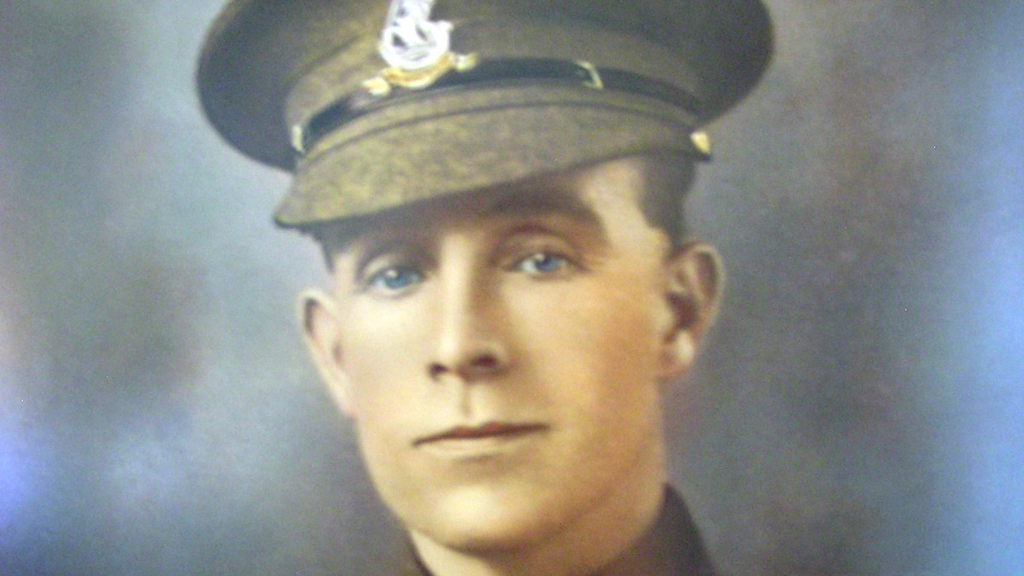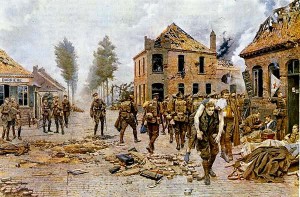During the Great War Hitler claimed that he was wounded on the Western Front and recalled that a British soldier pointed his gun at him and then deliberately did not fire. He later also claimed that this was proof of divine intervention and his destiny to lead Germany to a greater future.
The claim is that is was Warwickshire Pte Henry Tandey who was the British soldier that spared Hitler’s life.
The Story
 On September 28, 1918, in an incident that would go down in the lore of World War I history—although the details of the event are still unclear—Private Henry Tandey, a British soldier serving near the French village of Marcoing, reportedly encountered a wounded German soldier and declined to shoot him, sparing the life of 29-year-old Lance Corporal Adolf Hitler.
On September 28, 1918, in an incident that would go down in the lore of World War I history—although the details of the event are still unclear—Private Henry Tandey, a British soldier serving near the French village of Marcoing, reportedly encountered a wounded German soldier and declined to shoot him, sparing the life of 29-year-old Lance Corporal Adolf Hitler.
Tandey, a native of Warwickshire, took part in the First Battle of Ypres in October 1914 and the Battle of the Somme in 1916, where he was wounded in the leg. After being discharged from the hospital, he was transferred to the 9th Battalion in France and was wounded again during the Third Battle of Ypres at Passchendaele in the summer of 1917. From July to October 1918, Tandey served with the 5th Duke of Wellington Regiment; it was during this time that he took part in the successful British capture of Marcoing, for which he earned a Victoria Cross for “conspicuous bravery.”
As Tandey later told sources, during the final moments of that battle, as the German troops were in retreat, a wounded German soldier entered Tandey’s line of fire. “I took aim but couldn’t shoot a wounded man,” Tandey remembered, “so I let him go.” The German soldier nodded in thanks, and disappeared.
Though sources do not exist to prove the exact whereabouts of Adolf Hitler on that day in 1918, an intriguing link emerged to suggest that he was in fact the soldier Tandey spared. A photograph that appeared in London newspapers of Tandey carrying a wounded soldier at Ypres in 1914 was later portrayed on canvas in a painting by the Italian artist Fortunino Matania glorifying the Allied war effort. As the story goes, when British Prime Minister Neville Chamberlain traveled to Germany in 1938 to engage Hitler in a last-ditch effort to avoid another war in Europe, he was taken by the führer to his new country retreat in Bavaria. There, Hitler showed Chamberlain his copy of the Matania painting, commenting, “That’s the man who nearly shot me.”
The authenticity of the Tandey-Hitler encounter remains in dispute, though evidence does suggest that Hitler had a reproduction of the Matania painting as early as 1937—a strange acquisition for a man who had been furious and devastated by the German defeat at Allied hands in the Great War. Twice decorated as a soldier, Hitler was temporarily blinded by a mustard gas attack in Belgium in October 1918 and was in a military hospital in Pacewalk, Germany, when he received news of the German surrender. The experiences of battle—first glory and ultimately disillusion and despondence—would colour the rest of Hitler’s life and career, as he admitted in 1941, after leading his country into another devastating conflict: “When I returned from the War, I brought back home with me my experiences at the front; out of them I built my National Socialist community.”
Examining the Evidence
This BBC documentary looks at the evidence …







You must be logged in to post a comment.